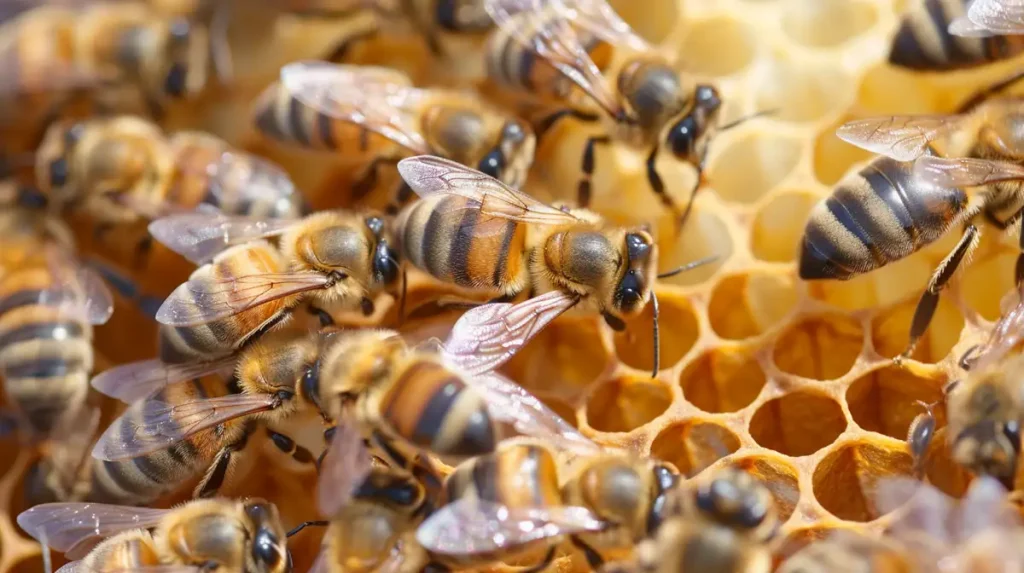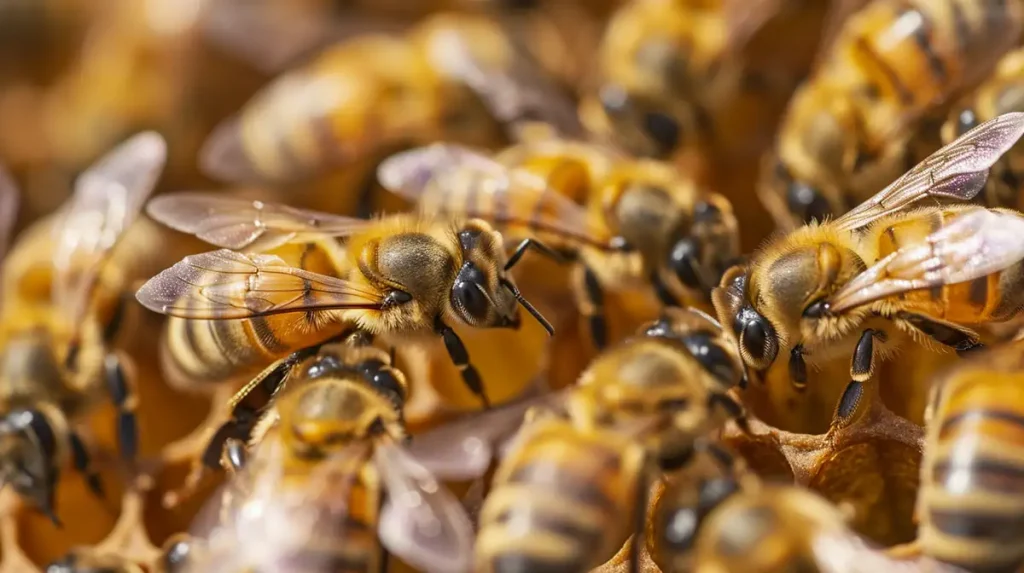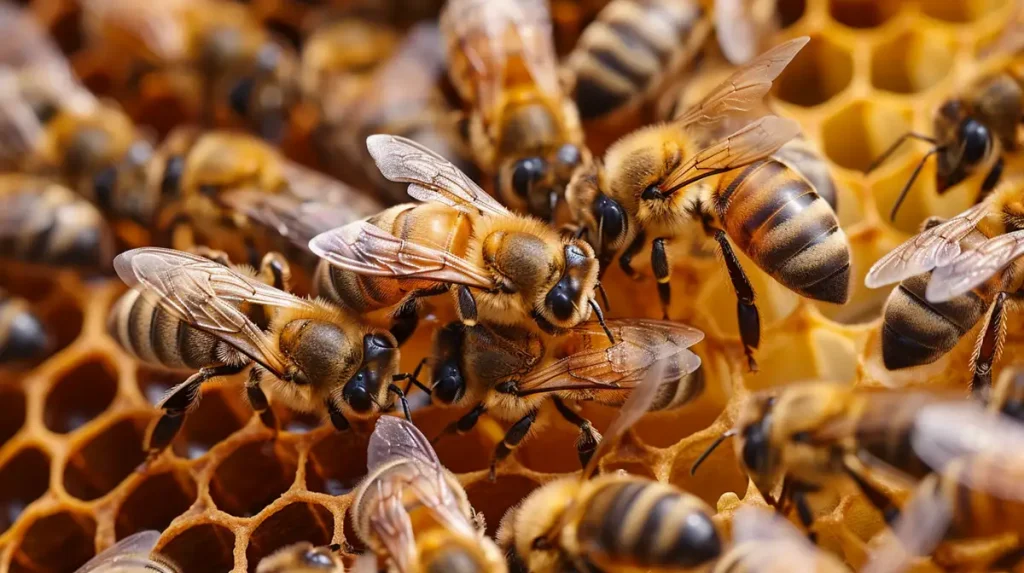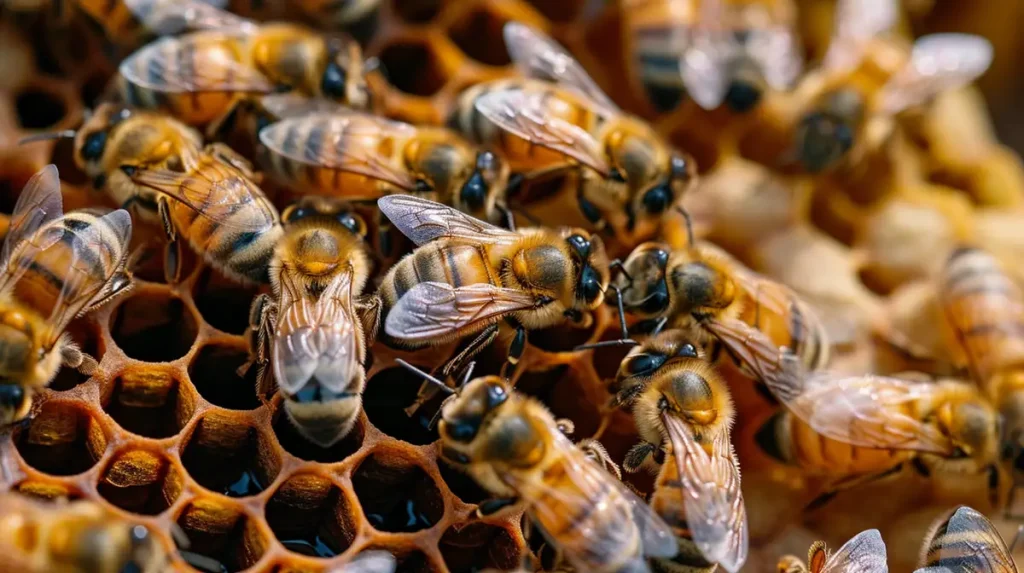Table of Contents
If you’re a beekeeper, you know how crucial the queen bee is to the health and productivity of a colony. Without her, the colony can’t survive. However, queen bees have a limited lifespan and their quality can decline over time. This is where queen rearing comes in. By breeding your own queens, you can ensure the health and productivity of your colonies. In this article, I will provide an overview of queen rearing and guide you through the process of breeding your own queens.
Key Takeaways
- Queen bees are essential for the health and productivity of a bee colony, as they are the only sexually mature females and their main purpose is to lay eggs.
- There are two main methods of queen rearing: natural and artificial, with the latter involving techniques such as grafting, queen cell starter kits, and mating nucs.
- Preparing to breed queens involves assessing the health of the colony, choosing the right parent stock, and preparing the breeding equipment.
- Ensuring a suitable environment for queen cells to develop is crucial, regardless of the artificial rearing method chosen.
- Managing the queen rearing process involves monitoring the progress and maturity of queen cells, introducing them to the colony at the appropriate time, and ensuring their acceptance by the colony.
- Challenges in queen rearing include poor weather conditions, inadequate equipment, and improper timing, which can be addressed through best practices like choosing healthy parent stock, using quality equipment, and paying attention to proper timing.
- Patience, attention to detail, and record-keeping are critical to the success of queen rearing, as they help improve the process and the quality of queens produced.
Here’s a detailed table with some lesser-known tips and tricks related to queen bee rearing:
| Topic | Description |
|---|---|
| Grafting Techniques | Learn different grafting methods such as the Hopkins method, Chinese method, or Doolittle method for transferring larvae to queen cups. |
| Timing of Grafting | Understand the optimal age of larvae (usually 12-24 hours old) for grafting to ensure the development of high-quality queen bees. |
| Royal Jelly Feeding | Provide royal jelly consistently to developing queen larvae for optimal growth and development. Consider using natural or artificial sources of royal jelly. |
| Cell Builder Colony Management | Manage cell builder colonies effectively by providing adequate nutrition, population, and age structure to ensure the production of robust queen cells. |
| Controlled Environment | Maintain a controlled environment with stable temperature and humidity levels during queen cell development to prevent stress and ensure successful emergence. |
| Genetic Selection | Choose breeder queens with desirable traits such as productivity, gentleness, disease resistance, and hygienic behavior to improve the quality of queen bees. |
| Mating Nuc Preparation | Prepare mating nucs with proper ventilation, sufficient space, and abundant food resources to facilitate successful mating and subsequent egg-laying by the queen. |
| Mating Nuc Placement | Strategically place mating nucs in locations with abundant drone populations and diverse forage to maximize mating success and genetic diversity. |
| Queen Introduction Techniques | Employ various queen introduction techniques such as the newspaper method, push-in cage method, or candy release method to ensure acceptance by the colony. |
| Colony Strength Assessment | Regularly assess colony strength and health to determine the suitability of introducing a new queen and to prevent rejection or supersedure. |
These tips and tricks can greatly enhance the success rate of queen bee rearing and contribute to the overall health and productivity of bee colonies.
The Biology of Queen Bees
Before we dive into the details of queen rearing, it’s essential to understand the biology of queen bees. Queen bees are the only sexually mature females in a colony, and their sole purpose is to lay eggs. They have a longer lifespan than other bees, up to five years in some cases, and can lay up to 2,000 eggs per day. The queen bee’s anatomy is unique, with a larger abdomen and reproductive system than other female bees. The queen bee’s life cycle is also different as she develops from an egg that has been fed a special diet of royal jelly. Mating behavior is also critical to queen bees. They mate with multiple drones during a single mating flight, which occurs early in their life.
Methods of Queen Rearing
There are two main methods of queen rearing: natural and artificial. Natural queen rearing occurs when a colony raises a new queen by itself while artificial queen rearing involves the beekeeper playing a more active role in the process. When choosing a method, several factors need to be considered including the size of the colony, the time available, and the experience level of the beekeeper.
Preparing to Breed Queens
One of the most crucial steps in queen rearing is preparing to breed queens. Before starting the process, it’s essential to assess the health of the colony and choose the right parent stock. A healthy colony with good genetics is essential for producing high-quality queens that will lead productive and healthy colonies. To do this, the beekeeper needs to take several factors into account. These include:
- The health of the colony: The beekeeper needs to assess the health of the colony by checking for signs of disease or pests, such as Varroa mites. If the colony is not healthy, it’s not suitable for breeding queens. Addressing any health issues should be a top priority before proceeding with queen rearing.
- The age of the queen: The age of the queen bee is a crucial factor to consider when preparing to breed queens. A queen that is too old or too young may not be suitable for breeding. Queens that are at least a year old are typically good candidates for breeding.
- Genetics: The genetics of the parent stock play a critical role in the quality of the queen bees produced. It’s essential to choose bees that have desirable traits, such as productivity, gentleness, and resistance to disease.
Once the beekeeper has assessed the health of the colony and chosen the right parent stock, they need to prepare the breeding equipment. The equipment required will depend on the method of queen rearing chosen. For example, if the beekeeper is using the grafting method they will need a grafting tool and queen cups. If they are using queen cell starter kits, they will need to assemble the kit and provide food for the queen cells. Mating nucs also need additional equipment such as frames, feeders, and screens.
It’s essential to ensure that the breeding equipment is clean and free from disease or pests. Using contaminated equipment can affect the success of queen rearing and compromise the health of the colony.
Preparing to breed queens is a crucial step in the queen rearing process. A healthy colony with good genetics is essential for producing high-quality queens. Preparing the breeding equipment is also critical, as clean and disease-free equipment can help to ensure the success of the queen rearing process. By paying attention to these factors, beekeepers can increase their chances of producing high-quality queens and maintaining healthy colonies.

Artificial Queen Rearing Techniques
There are several artificial queen rearing techniques, and each one has its advantages and disadvantages. One of the most popular methods is grafting. This method involves transferring young larvae from the brood comb into a queen cup, where they will be raised into queen cells. The beekeeper carefully selects the larvae and transfers them using a grafting tool. The larvae are then placed into queen cups, which are specially designed cups that encourage the bees to raise the larvae into queen cells. Grafting is a delicate process and requires some skill and practice. However, it can be an effective way to produce high-quality queen bees.
Another popular method of artificial queen rearing is queen cell starter kits. These kits provide a pre-made environment for the queen cells to develop. The beekeeper simply needs to insert the queen cells into the kit and the bees will take care of the rest. Queen cell starter kits can save time and reduce the need for specialized equipment. Nevertheless, they can be more expensive than other methods of queen rearing.
Mating nucs are another artificial queen rearing technique that can be used to provide a separate location for the queen to mate, away from the main colony. Mating nucs are small hives that contain a few frames of brood and bees. The queen is introduced to the nuc and the bees will raise her as their own. The queen can then mate with drones outside of the main colony, which can help to reduce the risk of inbreeding.
Regardless of the method chosen, it’s essential to ensure that the queen cells are raised in a suitable environment. They require the right temperature, humidity, and food to develop correctly. If the environment is not suitable, the queen cells may not develop properly, or the resulting queens may be of poor quality.
- Carter, Anthony (Author)
- English (Publication Language)
- 194 Pages - 02/28/2024 (Publication Date) - Independently published (Publisher)
Regardless of the method of artificial queen rearing chosen, it’s important to provide a suitable environment for the queen cells to develop and to monitor their progress closely. With the right knowledge and equipment, beekeepers can successfully rear their own queens and maintain healthy and productive colonies.

Managing the Queen Rearing Process
Once the queen cells have been started, the beekeeper needs to monitor their progress and maturity closely. It’s crucial to ensure that the queen cells are developing correctly and that they have the right temperature, humidity, and food to develop into high-quality queen bees. Depending on the method used, it may take anywhere from 7 to 16 days for the queen cells to mature fully.
When the queen cells have matured, it’s time to introduce them to the colony. The appropriate time for introduction will depend on the method used. For example, if using the grafting method, the queen cells will need to be introduced when they are about 9 days old. If using queen cell starter kits, the queen cells can be introduced when they are 12 to 13 days old. The timing of introduction is critical and it’s essential to follow the guidelines for the chosen method closely.
It’s also important to monitor the introduction of new queens to ensure their acceptance by the colony. Introducing a new queen can be a delicate process and it’s vital to take the necessary precautions to ensure a successful introduction. One way to do this is to use a queen introduction cage, which allows the bees to get used to the queen’s pheromones before introducing her into the hive. It’s also important to ensure that the colony is not overcrowded and that there are enough resources for the new queen and the colony.
In some cases, the colony may not accept the new queen so the beekeeper may need to intervene. If the queen is not accepted within a few days, it may be necessary to introduce another queen or combine the colony with another. It’s essential to monitor the progress of the new queen closely and to take the necessary steps to ensure the health and productivity of the colony.
Managing the queen rearing process is critical to the success of the process. It’s essential to monitor the progress and maturity of the queen cells and to introduce them to the colony at the appropriate time. It’s also important to monitor the introduction of new queens and to take the necessary steps to ensure their acceptance by the colony. With the right knowledge and attention to detail, beekeepers can successfully rear their own queens and maintain healthy and productive colonies.

Challenges and Best Practices
Queen rearing can be a challenging process, and there are several common challenges that beekeepers may face. Poor weather conditions can affect the success of queen rearing, as can inadequate equipment or improper timing. For example, if the bees are not producing enough royal jelly or if the temperature is too cold or too hot, the queen cells may not develop correctly. Additionally, if the equipment is contaminated or not clean, it can also impact the quality of the queen bees produced. Beekeepers need to be aware of these challenges and take steps to address them.
To improve the success rate of the queen rearing process, there are several best practices that beekeepers can follow. Choosing healthy parent stock is critical, as it can ensure that the offspring have good genetics and desirable traits. It’s also essential to use quality equipment that is clean and free from disease or pests. The beekeeper needs to pay attention to proper timing when selecting the right method and introducing new queens.
Patience, attention to detail, and record-keeping are also critical to the success of queen rearing. Queen rearing is a process that takes time, and beekeepers need to be patient and not rush the process. Attention to detail is essential, as the beekeeper needs to monitor the progress of the queen cells and new queens closely. It’s important to keep records of the process, such as the genetics of the parent stock, the method used, and the timing of each step. This information can help the beekeeper to improve the success of future queen rearing attempts.
Queen Rearing – Conclusion
Breeding your own queens is an excellent way to ensure the health and productivity of your colonies. With the right knowledge and tools, any beekeeper can successfully rear their own queens. Remember to choose healthy parent stock, select the right method, and pay attention to detail throughout the process. With these tips and a little bit of practice, you’ll be on your way to producing high-quality queens and maintaining healthy colonies for years to come. Happy queen rearing!
FAQs
Q: What is queen rearing?
A: Queen rearing is the process of selectively breeding and raising queen honey bees for beekeeping purposes. This practice aims to enhance desirable traits in the colony, such as honey production, disease resistance, and gentle temperament, while maintaining healthy bee populations.
Q: Why is queen rearing important in beekeeping?
A: Queen rearing is essential because a healthy and productive queen bee lays the foundation for a thriving colony. By raising high-quality queens, beekeepers can ensure that their colonies remain strong, productive, and resistant to diseases and pests. Additionally, replacing an old or underperforming queen can help prevent swarming.
Q: How long does it take to rear a queen bee?
A: The entire queen rearing process, from grafting a larva to having a mated and egg-laying queen, takes approximately 16-24 days. This includes 5 days as an egg, 6 days as a larva, 7-8 days as a pupa, and another 3-5 days for mating flights and egg-laying initiation.
Q: What is grafting in queen rearing?
A: Grafting is the process of transferring young bee larvae from worker cells into special queen cups, where they will be raised to become queen bees. Typically, larvae less than 24 hours old are chosen for grafting, as they have the highest potential to develop into successful queens.
Q: What is a queen cell?
A: A queen cell is a special, peanut-shaped cell in which a queen bee develops from an egg. Worker bees build these cells when they recognize the need for a new queen, either due to the current queen’s poor performance, her absence, or in preparation for swarming.
Q: How does a queen bee mate?
A: A queen bee mates with multiple male bees, known as drones, during a mating flight. Mating flights usually take place within the first few weeks of a queen’s life, and she stores the sperm collected during these flights in her spermatheca for use throughout her lifetime.
Q: Can I rear queens from any colony?
A: While it is technically possible to rear queens from any colony, it is best to select a colony with desirable traits such as high honey production, disease resistance, and gentle temperament. This increases the likelihood of producing high-quality queens that will contribute positively to your apiary.
Q: How do I introduce a newly reared queen to an existing colony?
A: Introduce the new queen to the colony by placing her in a queen introduction cage, which prevents the worker bees from immediately attacking her. The cage allows the colony to become accustomed to the new queen’s pheromones over several days. Once the workers start feeding and interacting positively with the queen through the cage, she can be safely released into the colony.
Q: Can I rear queens year-round?
A: Queen rearing is best done during the spring and early summer when weather conditions are favorable, and there are ample resources for the bees. Rearing queens during other times of the year may yield poor results due to limited forage, reduced drone populations for mating, and the natural tendency for colonies to consolidate during the colder months.
Q: How can I learn more about queen rearing techniques?
A: There are numerous resources available for learning about queen rearing, including books, online tutorials, and workshops hosted by local beekeeping associations. Connecting with experienced beekeepers in your area can also provide valuable insights and mentorship for developing your queen rearing skills.
Q: What equipment do I need for queen rearing?
A: Essential queen rearing equipment includes a grafting tool, queen cups, cell bars or frames, a queen rearing starter colony, a queen mating nuc, and a queen introduction cage. Additional tools, such as a magnifying glass, protective gear, and a smoker, can also be helpful in the process.
Q: What is a starter colony?
A: A starter colony, also known as a queenless cell builder, is a small group of worker bees prepared to accept and nurture grafted larvae for queen rearing. By removing the original queen and creating an environment of queenlessness, the starter colony is induced to prioritize raising new queens.
Q: How do I create a queen-right finisher colony?
A: A queen-right finisher colony is a strong colony that has its queen confined to a specific section of the hive using a queen excluder. This separation ensures that the queen does not interfere with the developing queen cells while allowing the worker bees to provide ample care and resources for the future queens.
Q: How many queens can I rear at once?
A: The number of queens you can rear simultaneously depends on the strength and resources of your starter and finisher colonies. Generally, a strong starter colony can accept up to 30 grafted larvae, while a strong finisher colony can nurture up to 60 developing queen cells.
Q: What is the best time of day to graft larvae?
A: The ideal time for grafting larvae is during the early morning or late afternoon when temperatures are cooler, and bees are less active. This reduces the risk of larvae drying out and makes it easier to work with the bees.
Q: How can I ensure high mating success for my queens?
A: To increase mating success, rear queens during periods of good weather with abundant drone populations. Place mating nucs in an area with drone congregating sites nearby and ensure that your queens have enough time for multiple mating flights. Providing diverse genetic stock in your apiary or surrounding apiaries can also contribute to successful matings.
Q: What should I do if my new queen fails to start laying eggs?
A: If a newly introduced queen fails to start laying eggs within two weeks, it is possible that she is not properly mated, or the colony has not fully accepted her. In this case, it may be necessary to replace her with another newly reared or purchased queen.
Q: Can I rear queens from a colony with a failing queen?
A: While it is possible to rear queens from a colony with a failing queen, it is not recommended. Rearing queens from a healthy and productive colony increases the chances of producing high-quality queens with desirable traits. If you must rear a queen from a failing colony, consider introducing new genetic material by purchasing a mated queen from a reputable source.
Q: How do I store queen bees before introducing them to a colony?
A: Queen bees can be stored in queen cages or specialized queen banks, which provide a controlled environment where worker bees can attend to the queens. Ensure that the queens have access to food, such as candy or fondant, and maintain an appropriate temperature of around 70°F (21°C). Avoid storing queens for extended periods, as this can reduce their overall performance.
Q: Can I sell the queens I rear to other beekeepers?
A: Yes, you can sell the queens you rear to other beekeepers, provided they meet quality standards and are healthy, mated, and productive. It is essential to accurately represent the traits and genetic lineage of your queens to potential buyers, and to follow local regulations and guidelines for queen bee transportation and sale.
Beekeeping Disclaimer:
Beekeeping, like any agricultural activity, involves inherent risks. It is important to understand these risks and take appropriate measures to mitigate them.
Potential risks associated with beekeeping include:
- Bee stings: Honey bees are generally not aggressive but can become defensive if they feel threatened or their hive is disturbed. Bee stings can cause allergic reactions or even anaphylaxis in some individuals, which can be life-threatening. It is important to wear protective clothing and follow best practices when handling bees to minimize the risk of stings.
- Diseases and pests: Bees can be vulnerable to various diseases and pests, including mites, viruses, and bacterial infections. These can have significant impacts on bee colonies, leading to reduced honey production or even colony collapse. It is important to monitor hives regularly and take appropriate measures to prevent and treat diseases and pests.
- Weather conditions: Extreme weather conditions, such as drought or cold temperatures, can affect the health and productivity of bee colonies. It is important to ensure that hives are appropriately sheltered and provided with adequate food and water.
- Environmental hazards: Bees can be affected by environmental hazards such as pesticide exposure, pollution, and habitat loss. It is important to be aware of these hazards and take appropriate measures to protect bee colonies and promote healthy environments for bees.
- Legal requirements: Beekeeping may be subject to local, state, or national regulations, such as registration or inspection requirements. It is important to be aware of these requirements and comply with them.
While beekeeping can be a rewarding and enjoyable activity, it is important to be aware of the potential risks and take appropriate measures to mitigate them. By following best practices and staying informed about the latest developments in beekeeping, beekeepers can help ensure the health and productivity of their hives and contribute to the well-being of bee populations worldwide.
Last update on 2024-04-17 / Affiliate links / Images from Amazon Product Advertising API




